We’re extremely excited to announce the release of Camunda Platform 8.0. This milestone marks a new era for Camunda Platform – the era of the Universal Process Orchestrator.
Camunda Platform 8 was designed from the ground up to meet the needs of today’s digital world. As global organizations continue to transform into a digital-first reality, there is an increasing need for performance at scale and high availability. Beyond performance, we continue to see businesses design processes in silos and struggle to connect people, systems, and devices for the end-to-end orchestration of complex, real-world processes. Enter Camunda Platform 8.
Camunda Platform 8 brings all the things you love about Camunda with added performance, scalability, availability, connectivity, and collaboration.
For additional background on the real-world problems that Camunda Platform 8 solves, check out this blog post from our product marketing team or our recent press release. If you still have questions, head on over to our official FAQ.
For existing Camunda Platform 7 users, we’ve created a dedicated blog post that walks you through the major changes between Camunda Platform 7 and Camunda Platform 8. If you want to learn more about migrating to Camunda Platform 8, you can also check out our Migration Guide.
If you are using Camunda Cloud today, the update process has not changed and is as smooth as ever.
Camunda Platform 8 represents what would have been the Camunda Cloud 1.4 release. Thus Zeebe, our battle-tested workflow engine, has also been updated from what would have been its 1.4 release to 8.0 to better align with the current platform version.
Next, we’ll introduce you to Camunda Platform 8 with an overview followed by details on the new capabilities delivered since the Camunda Cloud 1.3 release.
Introducing Camunda Platform 8
Camunda Platform 8 helps orchestrate complex business processes that span people, systems, and devices. With Camunda, business users collaborate with developers to model and automate end-to-end processes using BPMN-powered flowcharts, along with DMN decision tables that run with the speed, scalability, and resiliency required to compete in today’s digital-first world.
Camunda Platform 8 consists of the following components:
This blog post will provide an overview of each component followed by detailed information on what’s new for each of the above mentioned components. Let’s kick things off with Modeler.
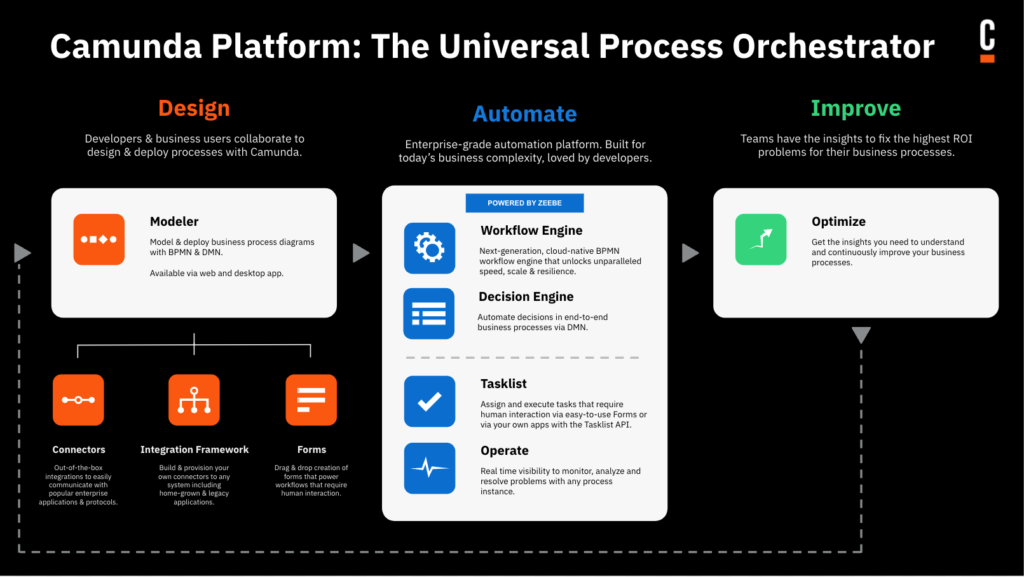
Modeler
Camunda Modeler unlocks deep collaboration between business users, who are intimately familiar with business processes, and IT, who develop the automation. By using industry-standard BPMN diagrams to model and automate end-to-end processes, teams can collaborate more easily and in one shared language. The diagrams can then be deployed to run process instances with speed, scalability, and resiliency to ensure that both IT and business goals are met.
New modeling experience
Camunda Platform 8 not only comes with Desktop Modeler, but also introduces the new Web Modeler for designing workflows directly in the web browser. We’ve added powerful collaboration features to enable developers and designers to work on processes together. In the Desktop Modeler, we’ve redesigned the UX to be more intuitive to model, including an easier-to-use properties panel to set the attributes of your model, and improved debugging capabilities to find and resolve model and deployment issues.
Web Modeler
Web Modeler allows you to create, model, and store processes, decisions, and forms in easy-to-navigate online folders. It also provides collaboration features like comments, and milestones with visual diffing of versions and projects. It enables you to make the processes and decisions executable directly – including deployment and the start of new process instances. We covered the main capabilities of this in our previous release blog post.
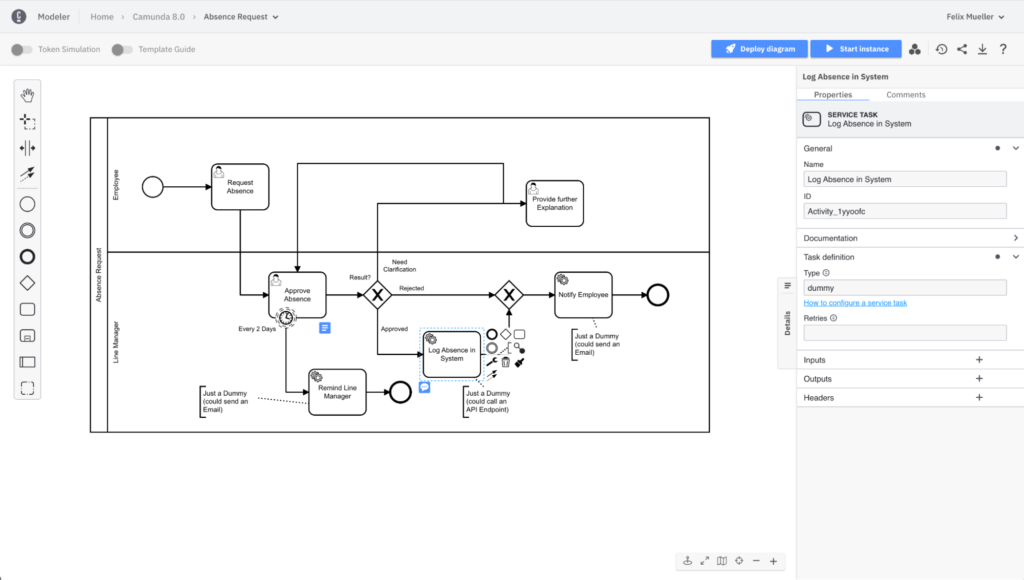
Token Simulation
In this release we are also adding our Token Simulation to Web Modeler:
Token Simulation allows you to quickly understand how your model will be executed with the help of visual tokens. This is a powerful feature, especially for larger diagrams—you can simulate the process flow and set conditions to evaluate all the parts of your process.
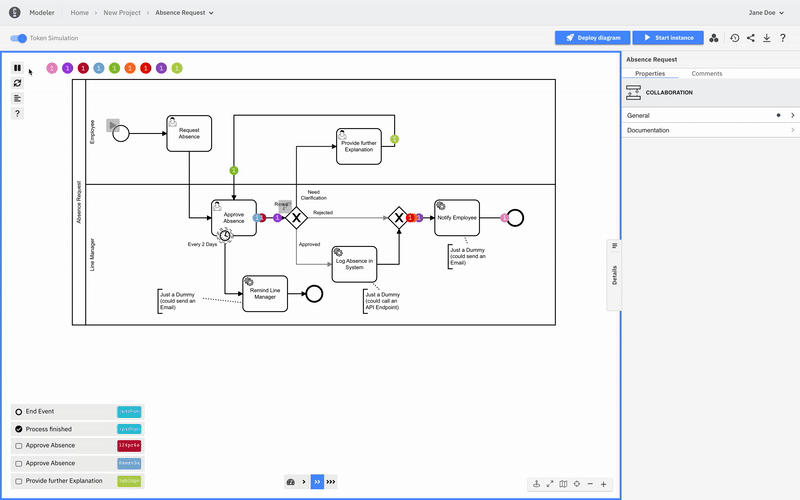
Desktop Modeler
Besides the Web Modeler, we overhauled our Desktop Modeler for the launch of Camunda Platform 8. Due to feedback from our community, we’ve made several improvements that now make it easier to model with intuitive layouts, updated features, and revamped interfaces for debugging and setting properties.
With Camunda Modeler 5.0, we’re introducing:
- Support for Camunda Platform 8, including DMN.
- A completely new look and feel—allowing you to focus on the important things when designing processes.
- Updated process debugging capabilities with intuitive helpers to resolve issues faster.
- A redesigned properties panel for easier navigation and fast access to contextual documentation.
- Support for element templates and plugins to extend Modeler.
- And much more!
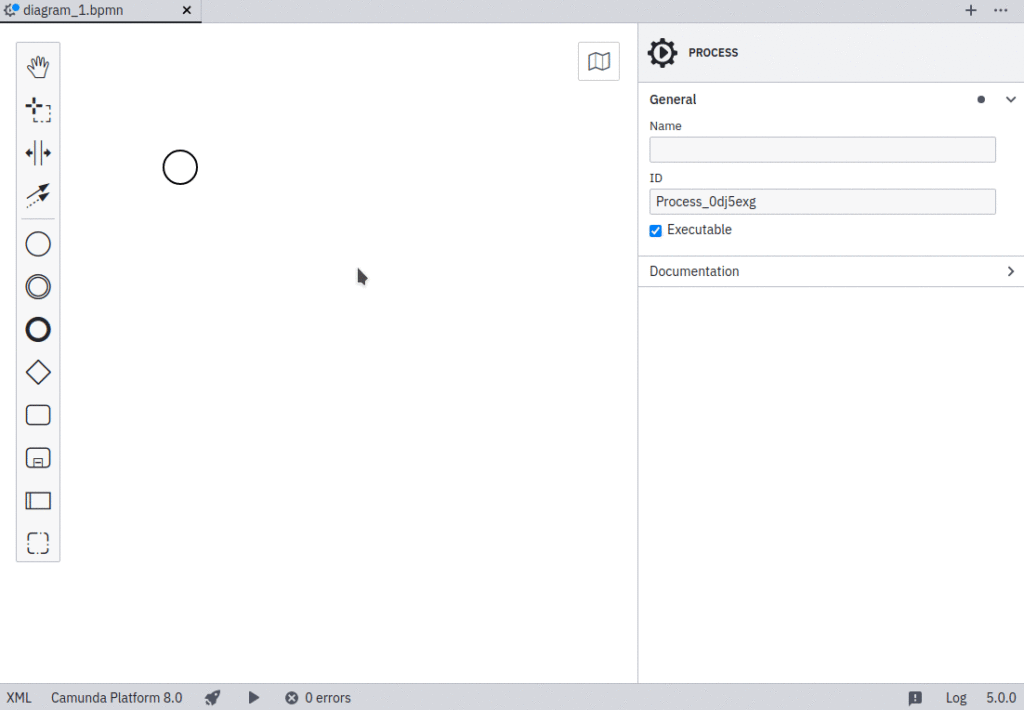
Read all about it in our Desktop Modeler 5.0 Released blog post.
Connectors — Developer Preview
Reusable connectors help you communicate with any system or technology, reducing the time it takes to automate and orchestrate business processes that span systems. Connectors are discovered in the context pad during modeling, and are inserted into BPMN diagrams directly from within the familiar Camunda Modeler interface. Once added to your diagram, they’re configured via an intuitive properties panel.
Connectors available in Web Modeler
In Camunda Platform 8 SaaS, we’re releasing out-of-the-box connectors that you can use directly in your process model. We’re starting with connectors for REST and SendGrid—both are available in Web Modeler.
The REST connector allows you to connect to any REST endpoint, using secure credentials. You can use the familiar GET, POST, PUT and DELETE methods, with the ability to map input and output variables for JSON objects sent or received by a REST Service. These variables can easily be parsed using FEEL expressions and reused by other elements in the process diagram.
The SendGrid connector lets you send emails via your SendGrid account. You can configure your account and email details to send a notification from your process. You can use the email service to send simple emails in plain text or HTML, or use dynamic templates from SendGrid.
You can access these connectors directly in the model from the context pad (click the element and choose the connector). In addition, you can securely configure your authentication credentials by setting a secret in Camunda Platform 8, accessed by a secrets variable in your process model.
Although we’re in Developer Preview mode, you can use both connectors in production. Developer Preview means we’re continuously iterating with more connectors to follow. In addition to out-of-the-box connectors, we will soon release a new integration framework that lets you build, deploy, and provision your own connectors while including all these features in both modeling applications. Share your feedback in our Camunda Community Forum, and check out the connectors documentation today.
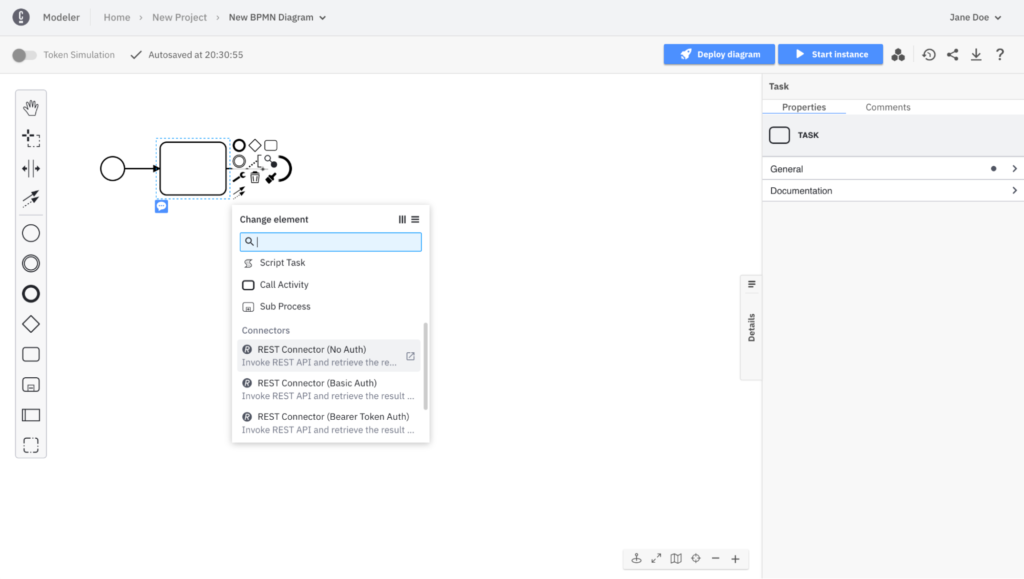
Workflow Engine — Powered by Zeebe
Camunda’s next-generation, cloud-native workflow engine, provides organizations with speed, scalability, security, and resiliency, without the overhead of building and maintaining infrastructure. Zeebe can scale throughput linearly by adding cluster nodes, allowing unlimited transactions to be processed with consistently low latencies. To ensure resilience, Zeebe comes with a new, fail-over architecture that also supports geo-replication across data centers to provide enterprise-grade availability.
Zeebe is source-available, and you’re invited to join our vibrant community on GitHub. Get started by learning more about its technical concepts in our documentation.
If you’re new to Zeebe, check out the details of its architecture in this blog post.
Zeebe Process Test
Software developers need a way to make sure that their processes and business logic are working as expected. To do so, it’s very common to write tests that validate the behavior.
In Camunda Cloud 1.3, we introduced a new solution for testing automated BPMN processes in JUnit 5 tests, called Zeebe Process Test. This functionality is especially geared towards Java developers, but we aim to provide further functionality for other languages in the future, too.
The new testing solution makes developers’ lives easier when automating processes, since the logic can be easily validated and tested before deployment. The solution can also be simply integrated into CI/CD environments.
Once added to your Java project, it allows you to easily deploy processes, start process instances, verify the specific steps in the process that have been passed, and check if the variables are set correctly.
With Camunda Platform 8, we’re adding official support for Zeebe Java Test.
To find more information about testing in our GitHub repository, check out Thomas Heinrichs’ video or read our Testing Best Practices.
Zeebe compression
With this release, it’s possible to enable compression for all internal traffic of a Zeebe cluster. This feature is useful when the network latency between the brokers is very high. For example, there are brokers deployed in different data centers. When latency is high, the network bandwidth is severely reduced. Hence, enabling compression helps to improve the throughput. But please be aware that when there is no latency, enabling this may impact performance. GZIP and Snappy are currently supported as compression algorithms. Please review the configuration file on how to enable this feature.
Job activations
In previous Zeebe versions, there was an issue with the client connection occasionally closing (long polling timed out, network interruption, client died, etc.) before the gateway could send an activate job response back to the client. This resulted in a job being marked as activated in the broker, even though it was never picked up by a client until the specific job timed out. This was acceptable in some cases, but if the job timeout was high, some users might have experienced a significant latency between the time a job was created and completed.
We fixed the issue in this release—see more details in GitHub.
Store temporal values as a variable from the expression result
Zeebe can now store the result of more expressions in a process instance variable. The following data types can now be stored in a variable: date, time, date-time, day-time-duration, year-month-duration. The value is stored as the FEEL’s extension of the ISO-8601 string representation. For more information, review the related pull request.
TLS improvements in Zeebe, Operate, and Tasklist
With this release, we’ve made internal communication between our components even more secure:
- We’re allowing users to configure TLS in Operate and Tasklist when connecting to the Zeebe Gateway. Review our documentation for more information on setting up TLS in Operate and Tasklist.
- Zeebe 8.0 supports overriding the authority used in the TLS handshake in the Java, Go, and CLI clients. Specifically, it allows you to override the hostname used in the hostname verification.
- In the Java client, you can override the authority using the .overrideAuthority method on the ZeebeClientBuilder API or the zeebe.client.overrideauthority configuration property.
- With the Go client, you can specify the OverrideAuthority of the ClientConfig to override the authority.
- For zbctl, the new authority flag allows you to override the authority.
In addition, all clients support the ZEEBE_OVERRIDE_AUTHORITY environment variable.
New DeployResource RPC
Camunda Platform 8 delivers support for the DeployResource RPC that replaces the deprecated DeployProcess RPC.
With this RPC, we shift the focus from deploying processes to deploying resources. Resources can be BPMN processes and DMN decision models as well (and we may add support for other resources in the future). The response provides the related metadata for the deployed resources, e.g., the decisionKey of a deployed decision.
This new RPC has already been implemented into the Java client, Go client, and zbctl. Client maintainers should review the changelog. We’ve introduced new APIs for each of them for backward compatibility to distinguish between the deprecated DeployProcess RPC and the new DeployResource RPC. We highly recommend moving to this new RPC.
Decision Engine — Powered by Zeebe
With this release, we’re introducing support for DMN in Camunda Platform 8. This allows you to use DMN decision tables and Decision Requirement Diagrams (DRDs) as part of your BPMN process and directly inspect the results and root-cause issues in Operate.
As a basis for DMN functionality inside of Zeebe, we’re using the Scala-based DMN engine that was previously a community-hub project. This DMN engine provides great coverage of FEEL already, and allows us to add additional DMN capabilities in an efficient way.
The functionality is available for both Camunda Platform 8 SaaS and Camunda Platform 8 Self-Managed installations.
To make use of this capability, you must first design DRDs and decision tables in Modeler (Desktop or Web):
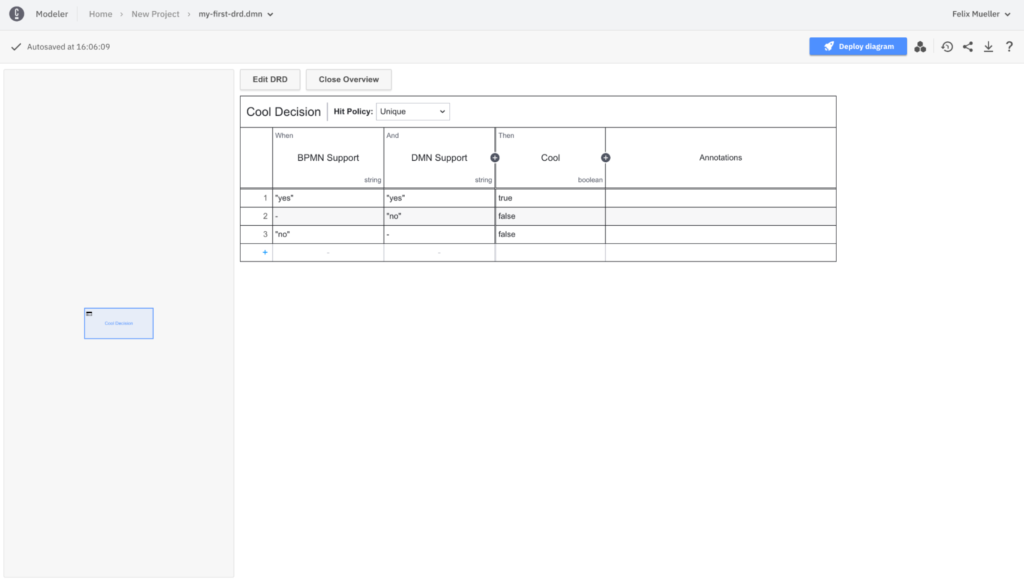
After designing the DMN, you can use them as part of a BPMN process by linking them in a Business Rule Task:
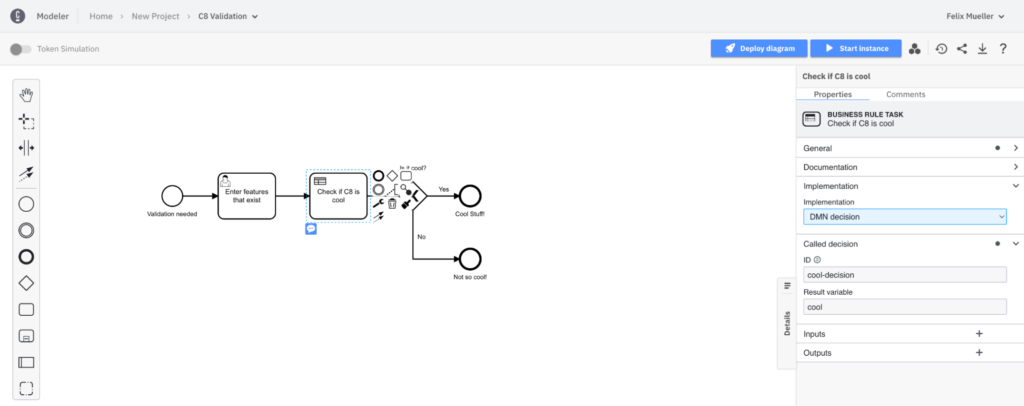
DMNs can be deployed to Zeebe using the deploy mechanisms of Modeler or directly via the client of your choice. After deployment, DMNs are visible in Operate and, once a decision has been evaluated, it can be visible as a decision instance directly in Operate:
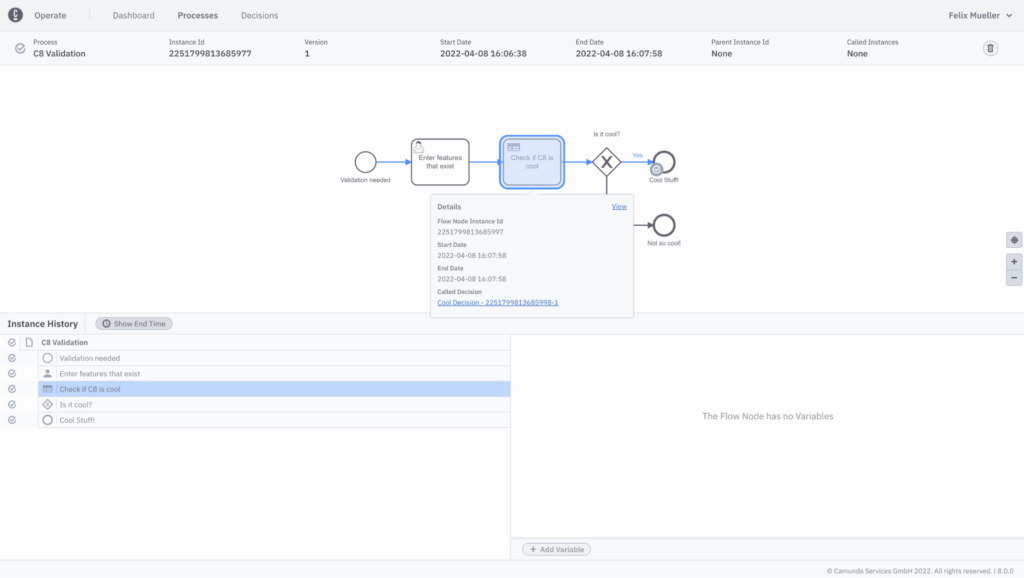
Operate allows you to drill down into the single decision evaluation as well:
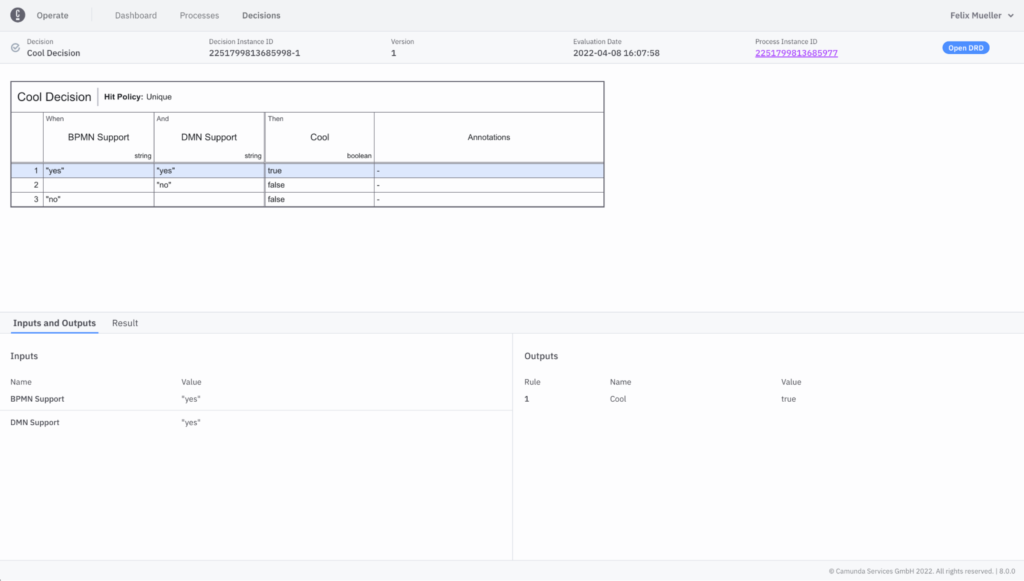
This also means we have significantly expanded Operate’s functionality—it now allows you to:
- Find the correct decision instance from a business rule task.
- Search for decision instances using filters.
- Drill down into specific decision instances to understand which rule has been hit or which input and output they have.
- Identify root cause problems and issues during decision evaluation.
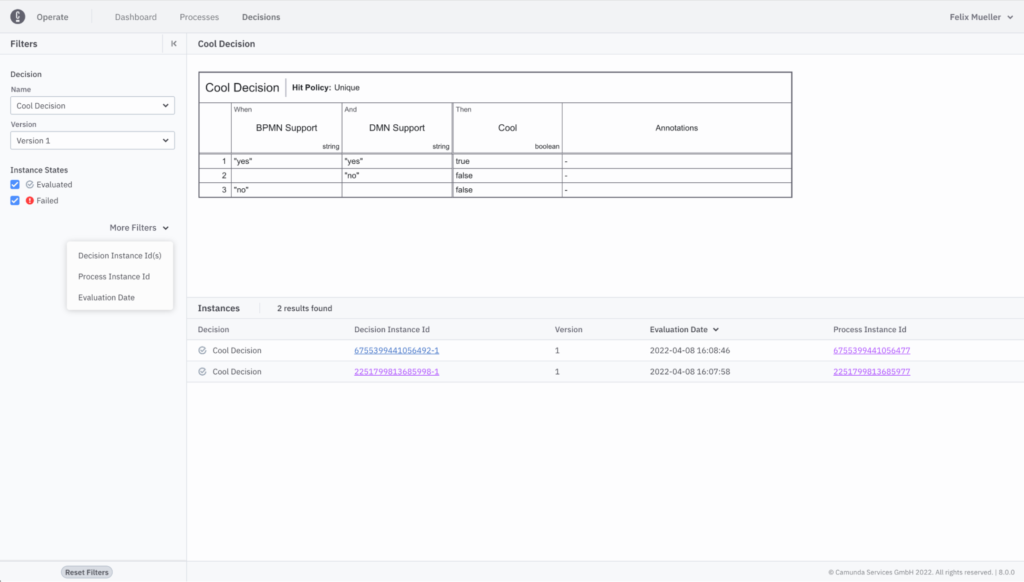
Operate
Operate is a tool for monitoring and troubleshooting process instances running in Camunda Platform 8. In addition to providing visibility into active and completed process instances, Operate also makes it possible to carry out key operations, such as resolving incidents and updating process instance variables.
New history REST API
With this release, we’ve made significant additions to Operate’s REST API that allows you to query and modify historic process automation data. The REST API is defined according to OpenAPI specifications that allow you to easily inspect available endpoints and try them out:
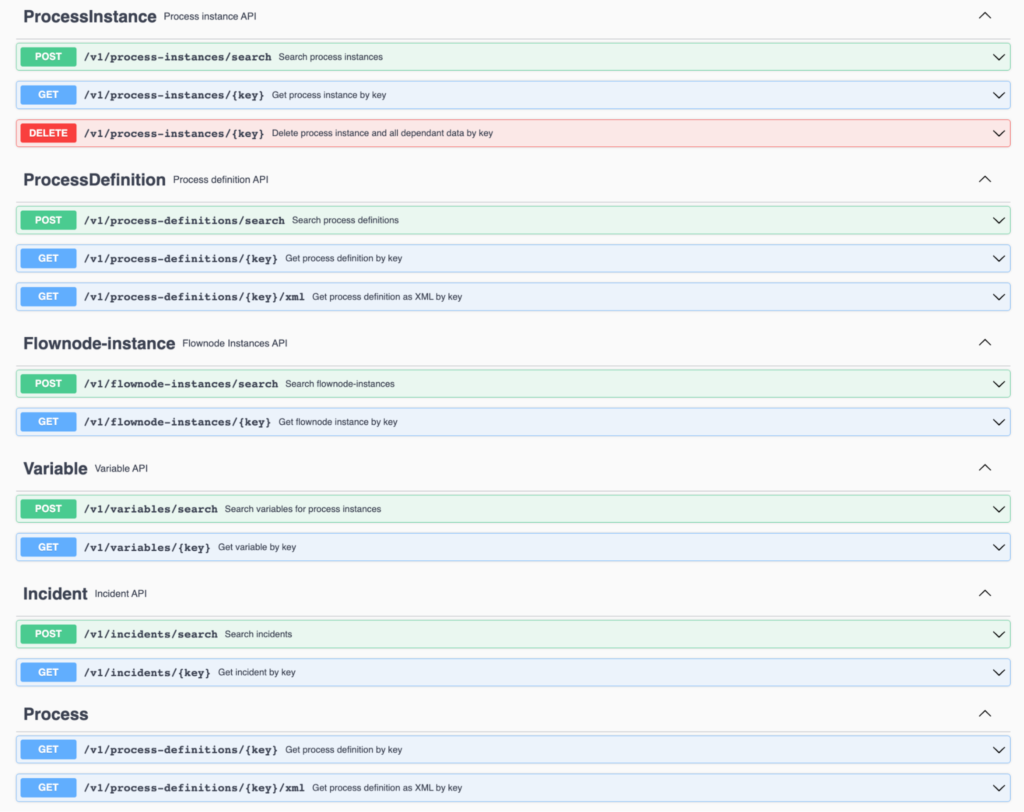
The new API is ideal if you need to integrate process automation data into existing applications or custom tools. One common use case for this API is to display the current state of the process instance and its flow nodes directly on a process diagram. This would require you to query a specific process definition XML, display this XML as a process diagram with the help of our bpmn-js library, and query for the state of the process instance and the related flow nodes.
The main endpoints are:
- Process definitions
- Process instances
- Flow nodes
- Variables
- Incidents
Below you can see an example of searching for all the process instances, including an example response from Operate’s REST API:
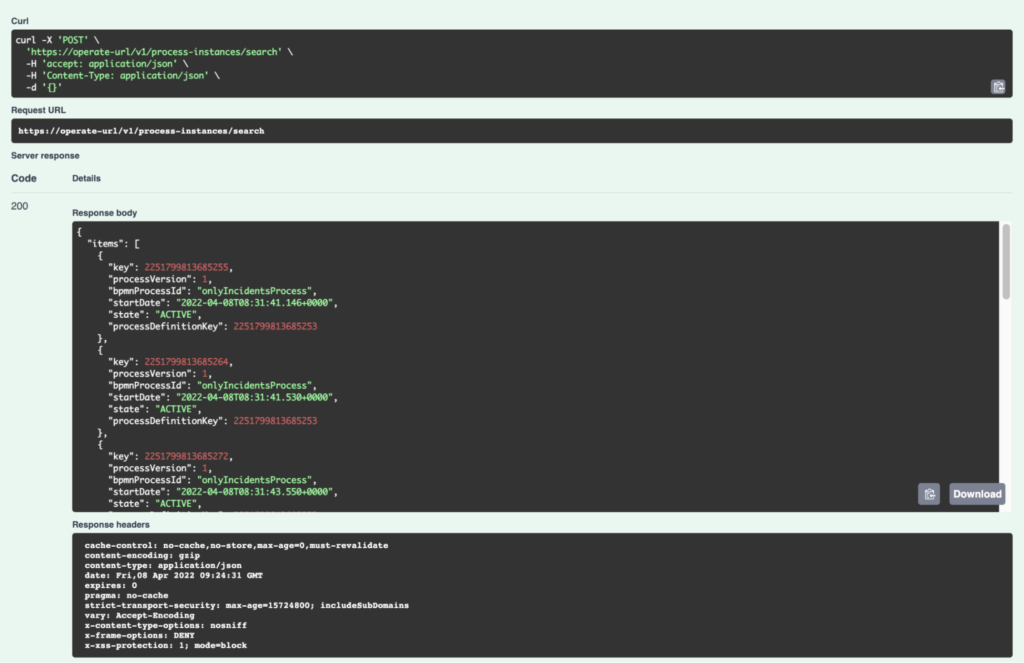
You can find all the defaults of this API in the Camunda Platform 8 documentation.
Tasklist
Tasklist enables process owners to create unified workflows that include tasks requiring human intervention and those that are fully automated.
You can use our built-in forms or easily integrate Tasklist with your apps while using our new GraphQL API. Follow our tutorial on how to build your own Tasklist.
Optimize
For process owners who want to perfect their critical processes, Optimize is an intelligence solution that leverages process execution data to continuously provide actionable insights. Unlike other business intelligence tools, Optimize specializes in BPMN-based analysis and can show users exactly what they need to do to succeed.
Process improvement with Optimize 3.8
Not all process automation investments lead to business success. You always need buy-in from your stakeholders, even if you know it’s necessary to improve a process. When you have 10 different processes to choose from, it gets even more challenging to identify the most critical thing to improve. Optimize 3.8 focuses on solving this problem.
This new release introduces the ability to set and track time-based business goals and features designed to make it easier to identify the most critical problems to solve.
Set and track time-based goals
- Process page: View the goal status of all your processes on a single page.
- Process owner: Assign responsibility for process health so you have the right conversation with the right person to fix a process.
- Time-based goals: Set and track data-driven guarantees on how long a process should take.
KPI reports
- Percentage reports: Create reports and alerts tracking percentages—like fully-automated instances or the incident-free rate (%) and the raw count.
- Duration percentile reports: Create reports tracking standard SLA statistics like P99 or P95 duration and the minimum, median, and maximum.
UX improvements
- Sample data: Start optimizing with a pre-loaded process and realistic data from day one.
- Legible variable names: Rename a variable like someVar_123, so your business stakeholders can understand your dashboards.
- Cleaner outlier analysis: In outlier analysis, we filter out irrelevant flow nodes, like gateways, to focus on outliers that matter.
- Rolling date dashboard filters: Apply a dashboard-level filter showing process performance over the last week, 30 days, or 90 days, to understand the KPI changes over time.
- Closed incidents: Analyze deleted incidents to understand if your DevOps team has handled incidents as expected.
- Dashboard and report type on import: Easily debug API-based dashboard and report import operations.
- Native JSON variable support: Optimize unpacks JSON variables, just like object variables, so you can analyze more data and gain more insights
New to Camunda Platform 8
- API access: Uses secure REST APIs to append business data, download report results, and more.
- Sharing: Share or embed dashboards and reports so that everyone can make data-driven decisions.
Read all the details in the Camunda Optimize 3.8.0 Release blogpost.
Console
With Console, teams can create, configure, manage, and monitor clusters for all environments, from development to production. In addition, Console offers control over organizational settings such as user management.
Single sign-on and role-based access control
Single sign-on in SaaS and Self-Managed
We are offering our Camunda Platform 8 Enterprise customers the possibility to integrate with their own single sign-on (SSO) solution.
When using Camunda Platform 8 – SaaS, you can choose from a range of integration possibilities, including SAML. Please reach out to us via our support channel if you would like us to set up SSO for your organization.
When using Camunda Platform 8 – Self-Managed, we’re introducing a new component called Identity, which replaces the previous IAM component. Identity utilizes Keycloak and allows you to manage users, roles, and permissions for Camunda Platform 8 components. It provides OpenID Connect and SAML support and supports connecting you to your own LDAP-based identity provider.
Read more in our documentation on setting up Identity in your infrastructure.
New roles and permissions in SaaS
On top of that, we’re introducing additional roles and permissions for the SaaS Edition.
With the help of the new roles, you can have specific users who only have access to Tasklist or read-only access to Operate.
Besides owner and admin roles, the following roles are also available, providing dedicated rights for specific elements in Camunda Platform 8:
- Operations engineer – Full access to Console and Operate, except cluster deletion privileges.
- Analyst – Full access to Optimize and read-only access to clusters.
- Task User – Full access to Tasklist and read-only access to clusters.
- Developer – Full access to Console, without deletion privileges, and full access to Operate and Tasklist.
- Visitor – Read-only access.
Learn more about roles in our documentation.
The roles, as shown above, can be set up in Camunda Platform 8 – Self-Managed in a similar way.
New Google Cloud platform regions in SaaS
Camunda Platform 8 – SaaS is available in different Google Cloud platform regions, including Europe and US-East. With this release, we’re also introducing US-Central.
When running on our Enterprise Edition, you can choose where to run your cluster. Reach out to us if there is a specific region you need that we do not have listed yet.
Simplified deployment with supported Helm charts
In order to simplify operations of Camunda Platform 8 in your Kubernetes infrastructure, we added official support for Helm charts.
Helm allows you to choose exactly what chart (set of components) you want to install, and how these components need to be configured. It simplifies the installation, configuration, and updates for components running in a Kubernetes infrastructure.
We’ve invested a lot of effort in giving you the best user experience with getting started. By default, the Helm charts are configured in a way that they can directly go into production and have all services available. Depending on your requirements, you might want to check out our best practices around sizing. All possible configurations are documented on GitHub.
These changes also include a completely overhauled installation guide for Camunda Platform 8 Self-Managed.
We test our official Helm charts on a regular basis—read more about these details.
We recommend using the new Helm charts when deploying Camunda Platform 8 to production.
Originally, the Helm charts were introduced by community contributors. We would like to thank all the contributors and supporters of Camunda Platform 8 Helm, previously known as Camunda Cloud Helm, and Zeebe Helm: https://github.com/camunda/camunda-platform-helm/graphs/contributors
Updating to Camunda Platform 8
Camunda Cloud to Camunda Platform 8
Updating from Camunda Cloud to Camunda Platform 8 is straightforward:
You can keep your existing running and completed process instances, existing process diagrams, and worker integrations. For most of the API and client-side, we’re keeping our backward compatibility.
Note that the new version of the Go client (v8) comes with a small change—the major version is now part of the package name github.com/camunda/zeebe/clients/go/v8. This means you’ll need to adjust your imports accordingly. This change was necessary due to special versioning restrictions in Go.
If you’re running Camunda Cloud as Self-Managed and using the IAM component, you’ll need to replace IAM with our new Identity component. You’ll also need to set up the roles and permissions, and integrate with your identity system from scratch.
You can read more about these updates in our update guide.
Camunda Platform 7 to Camunda Platform 8
If you’re running on Camunda Platform 7 today, we recommend checking out Camunda Platform 8. For those who’d like to migrate to Camunda Platform 8, we created a dedicated guide in our documentation for you.
This guide explains what migrating from Camunda Platform 7 to Camunda Platform 8 entails. Specifically, this guide outlines:
- The differences in application architecture.
- How process models and code can generally be migrated, whereas runtime and history data cannot.
- How migration can be simple and complicated.
- How you need to adjust code that uses the workflow engine API.
- How you might be able to reuse glue code.
- The community extensions that can help you with migration.
Try Camunda Platform 8
You can sign up now for a free 30-day trial of Camunda Platform 8.
We’ve also merged our Camunda Community Forums, so you can ask all your technical questions there.
In addition, there are other community extensions available for Camunda Platform 8 users that you can find in our Community Hub on GitHub.
Additional Camunda Platform 8 Resources
As always, we have a plethora of helpful resources you can take advantage of immediately. Here’s our quick-start recommendations:
- Attend our upcoming Camunda Platform 8 release webinar taking place live on April 28 as part of our “expert sessions” agenda during the Camunda Community Summit.
- Read our official Camunda Platform 8 release blog post.
- Check out Camunda Platform 8 FAQs for fast answers to common questions.
- Read through our extensive product docs.
- Reflections from Camunda Co-founders Jakob and Bernd.
- Our friends on the Camunda DevRel team have put together the ultimate Camunda Platform 8 post for Camunda Platform 7 users—you don’t want to miss this.
- Review the Camunda Automation Platform 7.17 release notes blog.
Editor’s note: This post has been slightly updated in March 2024 for clarity and correctness.
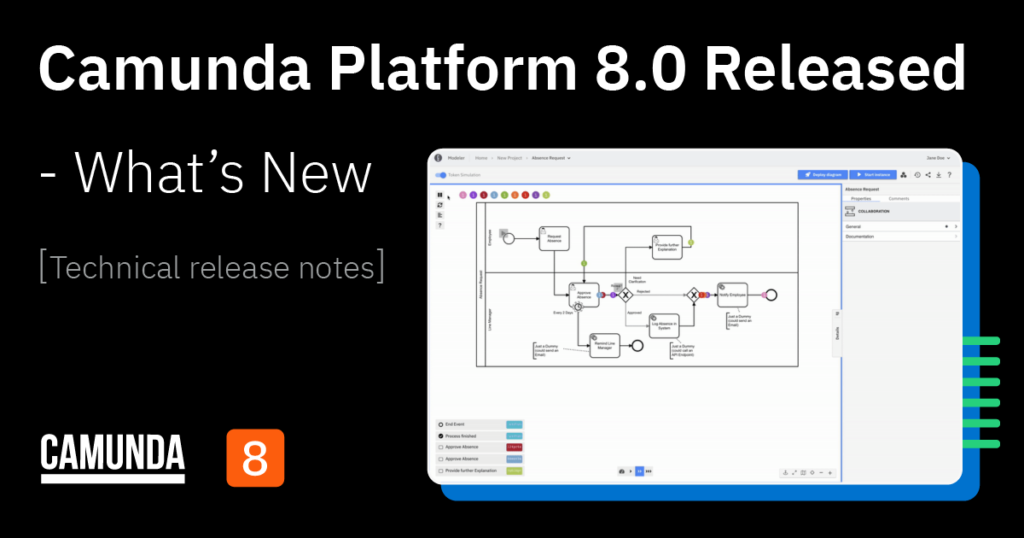

Start the discussion at forum.camunda.io